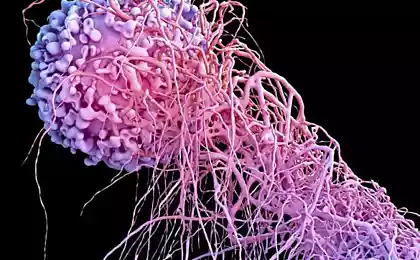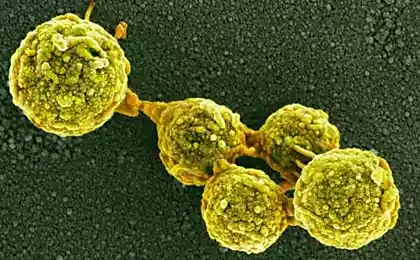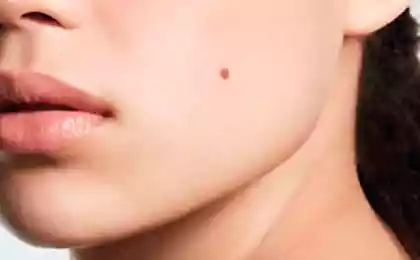240
All about moles and tanning: even some doctors are mistaken
In the Middle Ages, moles were considered marks of the devil. The presence of such a mark was considered confirmation that a person is engaged in witchcraft, and could cause burning at the stake.

In the XVIII century, the concept changed, and a mole over the lip began to be considered a sign of a passionate nature. Women deprived of the passion mark began to use flies: pieces of black patch, taffeta or velvet, they were glued to the face, chest and shoulders in the form of a mole.
In Europe, flies were considered not only the subject of makeup, but also a way of communicating and flirting. The fly placed at the upper lip meant that the girl was free for all sorts of proposals, and if she was on the right cheek - that she was married.
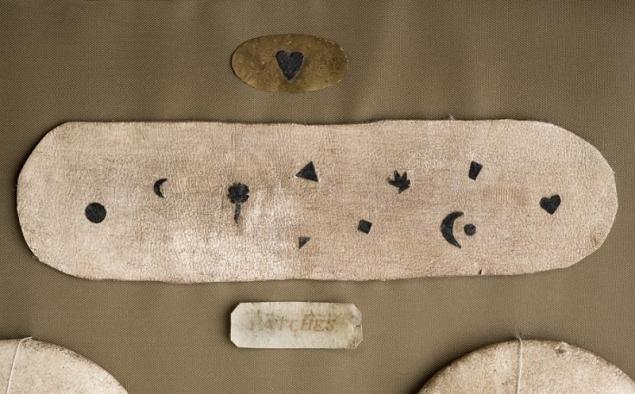
Today, moles are often associated with melanoma, one of the most aggressive types of skin cancer. And this explains the increased interest in them, as well as the emergence of numerous myths.
What do moles Modinka (med. - nevus) - is a pigment neoplasm of brown or dark brown color, containing melanocyte cells.

The main function of melanocytes is protective. They protect the skin and the whole body from the effects of ultraviolet radiation. pigment melanin, produced by melanocytes, acts as a barrier.
With normal work of the body and moderate stay under open sunlight on the human body there is a tan. Under certain circumstances, malfunctions in the body occur, as a result of which melanin is produced unevenly, provoking the appearance of pigment spots.

DepositPhotos
Melanocytes can accumulate inside different layers of the skin and be a source of benign (nevus) and malignant tumor (melanoma). Thus, moles (nevi) are, in fact, congenital benign neoplasms of the skin.
The appearance of new nevi is influenced by numerous factors.
Factors in the appearance of moles
Not all nevi are equally harmless. Doctors distinguish in a separate category the so-called dysplasticSometimes they are called atypical. Nevi of this species are not skin cancer, but you need to monitor them very carefully. If there are more than 5 dysplastic nevi on the human body, the risk of skin cancer increases by 10 times.

DepositPhotos
If you have a lot of such “happiness”, then you should definitely go to a consultation with an oncologist. In addition to the examination, during the consultation, dermatoscopy is performed - the most accurate and reliable method of diagnosing skin formations.
Thanks to the dermatoscope, the structure of the mole, its symmetry, color are studied, which makes it possible to make a preliminary diagnosis. Specialists often come up with abbreviations that are convenient for remembering. In the case of a medical examination of moles, it is ACCORD: asymmetry, edges, bleeding, color, size and dynamics.
With moles, tanning and melanoma, there are many false claims that most people believe. Some people say that people who have many moles are happy. Others start sounding the alarm only when an ordinary mole suddenly begins to grow and change its appearance. Still others do not remove neoplasms to the last, fearing serious illness.
Myths about moles and tanning
On average, an adult has about 30 moles. 80-90% of them appear before the age of 25. Even in identical twins, moles are in different places, let alone ordinary brothers or sisters.
British scientists came to the conclusion that the more moles a person has, the more likely that his DNA has special mechanisms to protect against aging. People with a large number of moles, although at a serious risk of cancer, on the other hand, have the opportunity to live longer.
Phones have learned to tell if a mole is malignant. The smartphone app Dermo Screen uses very sensitive lenses to photograph and scan suspicious moles and birthmarks. This allows them to find malignant cells. The accuracy of the forecast during the tests was 85%.

DepositPhotos
According to Chinese astrologers, changes in the body occur under the influence of emotions or physiological reactions to life events. So moles can make some diagnoses and adjust treatment.
In palmistry, a uniquely negative character is prescribed to moles located on the lines of the hands. They point to heavy karma and unpaid debts that a person has yet to work off.
A simple check with a doctor helps to detect cancer at an early stage and prevent it. "Site" I collected 10 symptoms that can be a sign of this terrible disease.
With the arrival of summer, the holiday season began, so you need to pay special attention to protecting the skin from the harmful effects of ultraviolet rays. We recommend that you try to prepare yourself natural remedies for a safe tan.

In the XVIII century, the concept changed, and a mole over the lip began to be considered a sign of a passionate nature. Women deprived of the passion mark began to use flies: pieces of black patch, taffeta or velvet, they were glued to the face, chest and shoulders in the form of a mole.
In Europe, flies were considered not only the subject of makeup, but also a way of communicating and flirting. The fly placed at the upper lip meant that the girl was free for all sorts of proposals, and if she was on the right cheek - that she was married.

Today, moles are often associated with melanoma, one of the most aggressive types of skin cancer. And this explains the increased interest in them, as well as the emergence of numerous myths.
What do moles Modinka (med. - nevus) - is a pigment neoplasm of brown or dark brown color, containing melanocyte cells.

The main function of melanocytes is protective. They protect the skin and the whole body from the effects of ultraviolet radiation. pigment melanin, produced by melanocytes, acts as a barrier.
With normal work of the body and moderate stay under open sunlight on the human body there is a tan. Under certain circumstances, malfunctions in the body occur, as a result of which melanin is produced unevenly, provoking the appearance of pigment spots.

DepositPhotos
Melanocytes can accumulate inside different layers of the skin and be a source of benign (nevus) and malignant tumor (melanoma). Thus, moles (nevi) are, in fact, congenital benign neoplasms of the skin.
The appearance of new nevi is influenced by numerous factors.
Factors in the appearance of moles
- Ultraviolet radiation (more sun or irradiation in the solarium - more pigment spots).
- Hormone levels – especially during puberty, pregnancy and menopause
- Taking hormonal drugs - contraceptives, for example.
- Skin diseases, including allergic manifestations.
Not all nevi are equally harmless. Doctors distinguish in a separate category the so-called dysplasticSometimes they are called atypical. Nevi of this species are not skin cancer, but you need to monitor them very carefully. If there are more than 5 dysplastic nevi on the human body, the risk of skin cancer increases by 10 times.

DepositPhotos
If you have a lot of such “happiness”, then you should definitely go to a consultation with an oncologist. In addition to the examination, during the consultation, dermatoscopy is performed - the most accurate and reliable method of diagnosing skin formations.
Thanks to the dermatoscope, the structure of the mole, its symmetry, color are studied, which makes it possible to make a preliminary diagnosis. Specialists often come up with abbreviations that are convenient for remembering. In the case of a medical examination of moles, it is ACCORD: asymmetry, edges, bleeding, color, size and dynamics.
With moles, tanning and melanoma, there are many false claims that most people believe. Some people say that people who have many moles are happy. Others start sounding the alarm only when an ordinary mole suddenly begins to grow and change its appearance. Still others do not remove neoplasms to the last, fearing serious illness.
Myths about moles and tanning
- Myth #1. Removal of moles increases risk of skin melanoma
Italian scientists conducted a survey on moles among 1,000 women over the age of 20. And 82% of them confidently answered that removing moles is dangerous. This persistent myth is associated with the fear of melanoma and the so-called phenomenon of metastasis, characteristic of some malignant neoplasms. When removing large melanomas, in some cases, there is a violation of the delicate balance between the tumor and the immune system of its carrier. Tumor cells can metastasize.
But moles are not melanoma, they are benign formations on the skin that are not dangerous to the immune system and the body as a whole. No one will remove a mole without making sure the procedure is completely safe. So with current technology, removing moles is not dangerous.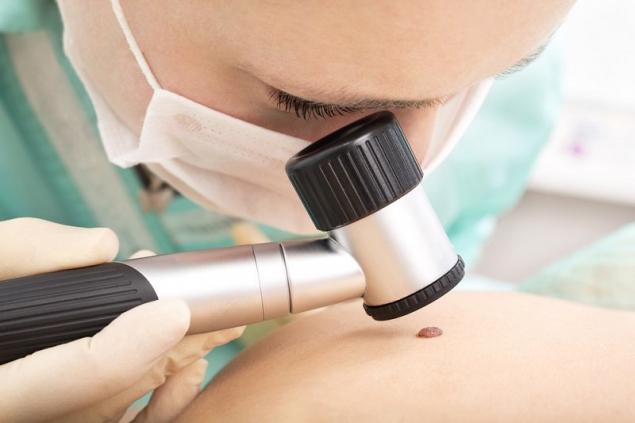
DepositPhotos - Myth 2. If a mole injury occurs, it must be removed.
In such a situation, you must first treat the wound with an antiseptic to avoid infection. Then apply a tool that stimulates tissue regeneration. And then make an appointment as soon as possible to see an oncologist or dermatologist in a medical institution. The injury itself is not a reason to remove it. But often internal pathological processes lead to changes, because of which it is easily injured. Therefore, an examination by a doctor is necessary to exclude the risk of melanoma. - Myth 3. Moles should be lubricated with sunscreen
At least 5% of people actually lubricate moles and the skin around them with sunscreen without applying it to the rest of the skin. Another 6% do not do this, but believe that it should be done. Studies have shown that ordinary clean skin suffers from sunlight much more moles. To this conclusion, scientists came by analyzing the number of compounds formed in the skin under the influence of UV rays and demonstrating the degree of DNA damage. In moles, these compounds were 3-5 times less than in the surrounding skin.
DepositPhotos - Myth 4. The skin will not tan if it is cloudy and raining outside.
UV rays penetrate clouds, so our skin tans during the day, even if it rains outside. But the intensity of radiation varies depending on weather conditions and the time of year. Today, every smartphone in the weather app has a UV index. He will tell you how to properly prepare your skin. For example, if the UV index is 1 or 2, use sunscreen with SPF 30.
If your UV score is 3 to 7, wear a headdress, sunglasses and choose loose clothing that hides your arms and legs. If the UV index is greater than 7, during the day keep in the shade and apply sunscreen to the whole body, and from 11:00 to 17:00 do not go outside. These rules apply even to those who are born with dark and dark skin.
- Myth 5. To remove moles, all means are good.
This amazing myth completely contradicts the many fears that wander among the population. Some citizens panic, hitting a mole with a sleeve, and the other part of the population mindlessly experimenting with folk remedies. Liquid nitrogen, a variety of preparations containing extracts of celandine, alkali, peroxide, vinegar, lemon with garlic ... Some of these funds really completely reduce both warts and moles. But, of course, there is no histology in this case.
But in the bowels of an innocuous externally mole, cells of a malignant tumor could hide. If some of these cells remained in the human body after removal of the nevus, the risk of developing full-fledged skin cancer increases many times.
This, by the way, concerns the burning of suspicious moles with a laser. If the material was not sent for histology, then there is no guarantee that the incipient melanoma was not treated with a laser, which after this procedure will begin to develop especially actively.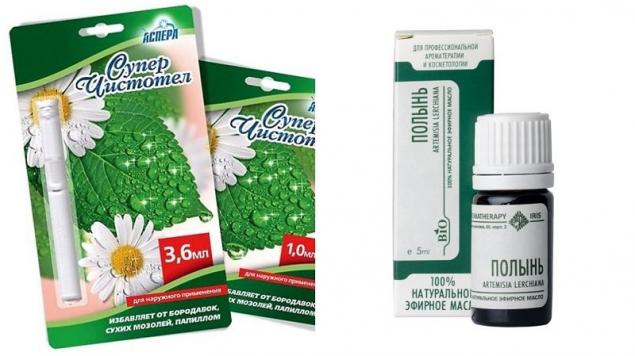
- Myth 6. Some people just have a lot of moles and freckles from birth. And there's no reason to worry.
There is a syndrome of multiple dysplastic nevi, when the whole body is covered with moles. Any of them can be reborn into a melanoma. People with this syndrome are recommended to be examined using a videodermatoscope. It takes pictures of the skin and allows you to track the appearance of new moles, and a special lens for fluorescent diagnosis will distinguish pathology from healthy skin.
DepositPhotos - Myth 7. Remove only dangerous moles
Doctors will quickly remove any mole if it interferes physically or looks aesthetically unattractive. For example, if you are afraid of damaging her clothes or if she looks ugly on her face. It's absolutely safe for health. The main thing is to remove a mole only in a medical institution, where it will be sent for histological examination. This eliminates the chance to accidentally miss the formation, which began to turn into melanoma and could give metastases with improper removal.
On average, an adult has about 30 moles. 80-90% of them appear before the age of 25. Even in identical twins, moles are in different places, let alone ordinary brothers or sisters.
British scientists came to the conclusion that the more moles a person has, the more likely that his DNA has special mechanisms to protect against aging. People with a large number of moles, although at a serious risk of cancer, on the other hand, have the opportunity to live longer.
Phones have learned to tell if a mole is malignant. The smartphone app Dermo Screen uses very sensitive lenses to photograph and scan suspicious moles and birthmarks. This allows them to find malignant cells. The accuracy of the forecast during the tests was 85%.

DepositPhotos
According to Chinese astrologers, changes in the body occur under the influence of emotions or physiological reactions to life events. So moles can make some diagnoses and adjust treatment.
In palmistry, a uniquely negative character is prescribed to moles located on the lines of the hands. They point to heavy karma and unpaid debts that a person has yet to work off.
A simple check with a doctor helps to detect cancer at an early stage and prevent it. "Site" I collected 10 symptoms that can be a sign of this terrible disease.
With the arrival of summer, the holiday season began, so you need to pay special attention to protecting the skin from the harmful effects of ultraviolet rays. We recommend that you try to prepare yourself natural remedies for a safe tan.
A reliable brokerage company with a large number of clients
For those who are tired of jam: 5 ways to save berries in a completely new way











